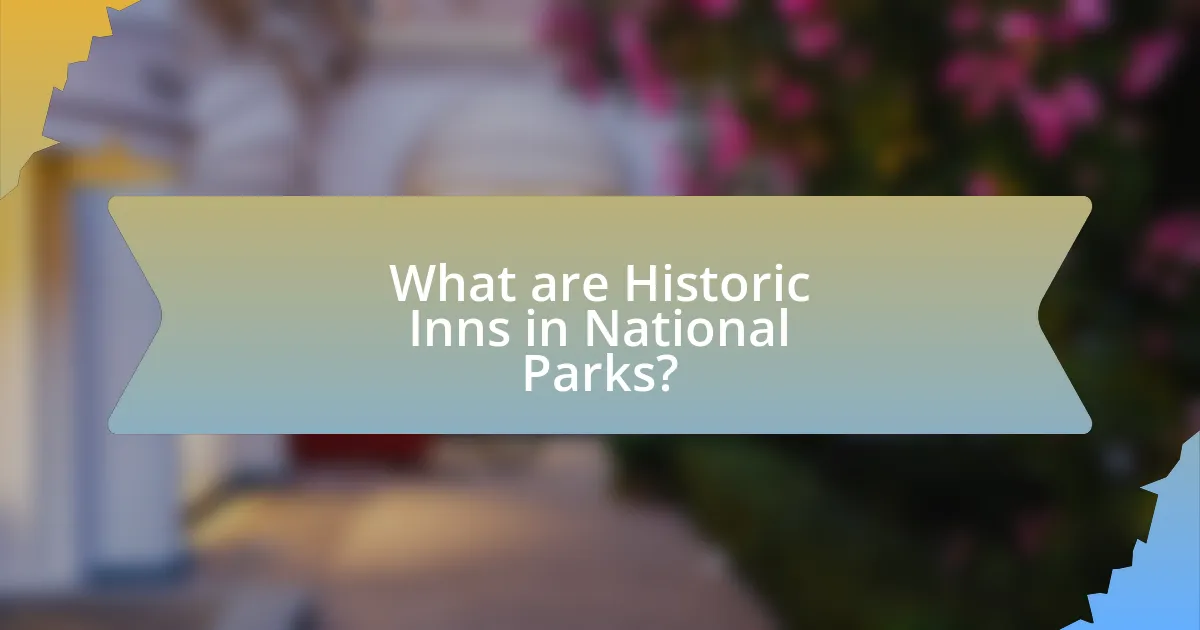Historic inns in national parks are accommodations that combine historical significance with natural beauty, often showcasing architectural styles from the early 20th century. These inns serve as important landmarks that reflect the cultural heritage and evolution of tourism in national parks, enhancing visitor experiences through unique architecture, personalized services, and proximity to natural attractions. The article explores the differences between historic inns and modern accommodations, highlights notable examples, and discusses their role in preserving park history. Additionally, it provides insights on selecting the best historic inn, engaging with local history, and understanding the challenges associated with staying in these unique lodgings.

What are Historic Inns in National Parks?
Historic inns in national parks are accommodations that offer a blend of historical significance and natural beauty, often located within or adjacent to national park boundaries. These inns typically feature architecture and decor that reflect the era in which they were built, providing guests with a unique experience that connects them to the park’s history. For example, many historic inns were constructed in the early 20th century, coinciding with the establishment of the national park system, and they often serve as a testament to the cultural heritage of the area. Their preservation is crucial for maintaining the historical narrative of national parks, as they provide insight into the early tourism and conservation efforts that shaped these protected landscapes.
How do Historic Inns differ from modern accommodations?
Historic inns differ from modern accommodations primarily in their architectural style, historical significance, and ambiance. Historic inns often feature unique, period-specific designs and furnishings that reflect the era in which they were built, such as Victorian or Colonial styles, whereas modern accommodations typically prioritize contemporary aesthetics and functionality. Additionally, historic inns may offer a sense of nostalgia and connection to the past, often being located in historically significant areas or having rich stories associated with them, while modern accommodations focus on convenience and amenities like technology and uniformity. This distinction is evident in the preservation of original features in historic inns, such as antique decor and traditional hospitality practices, contrasting with the streamlined, often standardized experience found in modern hotels.
What architectural styles are commonly found in these inns?
Common architectural styles found in historic inns within national parks include Colonial Revival, Craftsman, and Victorian. Colonial Revival inns often feature symmetrical facades, gabled roofs, and classic columns, reflecting early American architecture. Craftsman-style inns are characterized by their low-pitched roofs, exposed rafters, and extensive use of wood, emphasizing handcrafted details. Victorian inns showcase ornate decorations, intricate woodwork, and vibrant colors, representing the eclectic design trends of the 19th century. These styles not only enhance the aesthetic appeal of the inns but also connect visitors to the historical context of the regions they inhabit.
What historical significance do these inns hold?
These inns hold historical significance as they represent the architectural and cultural heritage of the national parks, often serving as landmarks that reflect the era of their construction and the evolution of tourism in these natural areas. For example, many of these inns were built in the early 20th century, during a time when the national parks were becoming popular destinations, showcasing the rustic style that aimed to blend with the surrounding landscapes. Their preservation allows visitors to connect with the history of conservation and the development of the national park system, as seen in structures like the Old Faithful Inn in Yellowstone, which was completed in 1904 and is a prime example of log cabin architecture that symbolizes the American wilderness experience.
Why are Historic Inns important for National Parks?
Historic inns are important for National Parks because they enhance visitor experience by providing unique accommodations that reflect the cultural and historical significance of the park. These inns often serve as gateways to the natural beauty and recreational opportunities within the parks, allowing guests to immerse themselves in the environment while enjoying amenities that promote comfort and relaxation. For instance, many historic inns are located in prime areas that offer easy access to hiking trails, scenic views, and educational programs about the park’s ecosystem and history. Additionally, they contribute to the preservation of local heritage, as many inns are restored landmarks that showcase architectural styles and stories from the past, thereby enriching the overall narrative of the National Park.
How do they enhance the visitor experience?
Historic inns in national parks enhance the visitor experience by providing unique accommodations that blend comfort with historical significance. These inns often feature architecture and decor that reflect the local heritage, allowing guests to immerse themselves in the culture and history of the area. For example, many historic inns are located near key attractions, offering convenient access to nature trails, scenic views, and educational programs, which enrich the overall visit. Additionally, personalized services and local culinary offerings at these inns create memorable experiences that connect visitors to the region’s traditions and flavors.
What role do they play in preserving park history?
Historic inns in national parks play a crucial role in preserving park history by serving as living museums that reflect the architectural styles, cultural narratives, and historical significance of their respective eras. These inns often house artifacts, photographs, and documents that provide insights into the park’s development and the experiences of past visitors. For example, the Old Faithful Inn in Yellowstone National Park, built in 1903, showcases rustic architecture and has been designated a National Historic Landmark, emphasizing its importance in the narrative of American conservation and tourism. By maintaining these structures and their stories, historic inns contribute to the ongoing education and appreciation of the park’s heritage.
What are some notable examples of Historic Inns in National Parks?
Notable examples of Historic Inns in National Parks include the Old Faithful Inn in Yellowstone National Park, built in 1903, which is renowned for its rustic architecture and proximity to the famous geyser. Another example is the Crater Lake Lodge in Crater Lake National Park, established in 1915, offering stunning views of the lake and surrounding landscape. Additionally, the Many Glacier Hotel in Glacier National Park, constructed in 1915, features Swiss chalet-style architecture and serves as a gateway to the park’s scenic beauty. These inns are significant for their historical value and unique locations within the national parks.
Which inns are recognized for their unique features?
The inns recognized for their unique features include the Old Faithful Inn in Yellowstone National Park, known for its rustic architecture and proximity to the iconic geyser, and the Crater Lake Lodge in Crater Lake National Park, celebrated for its stunning views of the lake and historic charm. The Old Faithful Inn, built in 1903, features a massive stone fireplace and log construction, making it a prime example of national park architecture. Crater Lake Lodge, established in 1915, offers guests breathtaking vistas and a blend of modern amenities with historic design elements. These inns are not only accommodations but also integral parts of the national park experience, enhancing visitors’ connection to nature and history.
What stories do these inns tell about the parks they are in?
The inns located within national parks tell stories of historical significance, cultural heritage, and the evolution of conservation efforts. Each inn often reflects the architectural style and local materials of its surroundings, showcasing the unique history of the park. For example, the Old Faithful Inn in Yellowstone National Park, built in 1903, embodies the rustic charm of the American West and serves as a testament to early tourism in national parks. These inns also highlight the relationship between human activity and nature, illustrating how they have adapted to the changing landscape and visitor needs over time. The stories told by these inns are intertwined with the parks’ narratives, emphasizing the importance of preserving both natural and cultural resources for future generations.

How can visitors choose the best Historic Inn for their stay?
Visitors can choose the best Historic Inn for their stay by evaluating factors such as location, historical significance, amenities, and guest reviews. The location should ideally be within or near a national park to enhance the experience of exploring nature and history. Historical significance can be assessed by researching the inn’s background, including its age and any notable events associated with it. Amenities like dining options, Wi-Fi, and guided tours can greatly influence comfort and convenience. Guest reviews on platforms like TripAdvisor or Yelp provide insights into the experiences of previous visitors, helping to gauge the quality of service and overall satisfaction.
What factors should be considered when selecting an inn?
When selecting an inn, key factors to consider include location, amenities, price, and guest reviews. The location should be convenient to attractions and activities within the national park, enhancing accessibility and experience. Amenities such as free Wi-Fi, breakfast options, and parking can significantly impact comfort and convenience during the stay. Price is crucial; it should align with your budget while reflecting the quality of service and accommodations offered. Guest reviews provide insights into the experiences of previous visitors, helping to gauge the inn’s reputation and service quality. These factors collectively ensure a satisfying and memorable stay at a historic inn in a national park.
How does location impact the choice of an inn?
Location significantly impacts the choice of an inn by determining accessibility, attractions, and the overall experience for guests. For instance, inns situated near national parks offer proximity to natural attractions, enhancing the appeal for outdoor enthusiasts. According to the National Park Service, over 300 million visitors frequent national parks annually, indicating a strong demand for accommodations nearby. Additionally, the location influences pricing; inns in prime areas often charge higher rates due to increased demand. Thus, the strategic placement of an inn can directly affect its occupancy rates and guest satisfaction.
What amenities should guests look for in a Historic Inn?
Guests should look for amenities such as complimentary breakfast, Wi-Fi, and unique historical decor in a Historic Inn. These features enhance the experience by providing comfort and a connection to the inn’s heritage. For instance, many historic inns offer locally sourced breakfast options that reflect the region’s culinary traditions, while Wi-Fi ensures modern connectivity. Additionally, the presence of original architectural elements or period furnishings can enrich the guest’s stay by immersing them in the history of the location.
What are the best times to visit these Historic Inns?
The best times to visit historic inns in national parks are typically during the spring and fall seasons. Spring, from late March to early June, offers mild weather and blooming landscapes, making it ideal for outdoor activities and sightseeing. Fall, from late September to mid-November, features vibrant foliage and comfortable temperatures, enhancing the overall experience. These periods also tend to have fewer crowds compared to the peak summer months, allowing for a more intimate visit. Historical data indicates that many national parks see a significant increase in visitors during summer, which can lead to longer wait times and less availability at inns.
How does the season affect the experience at these inns?
The season significantly affects the experience at historic inns in national parks by influencing the availability of activities, the ambiance, and the overall guest experience. For instance, during the summer months, guests can enjoy outdoor activities such as hiking and wildlife viewing, while winter offers opportunities for snow sports and cozy indoor settings. Additionally, seasonal events and local festivals can enhance the cultural experience, making stays more memorable. Historical data shows that occupancy rates at these inns vary with the seasons, peaking in summer and winter holidays, indicating that guests are drawn to the unique offerings each season provides.
What events or activities are available during peak seasons?
During peak seasons in national parks, visitors can participate in guided tours, wildlife watching, and ranger-led programs. These activities are designed to enhance the experience of exploring the natural beauty and historical significance of the parks. For example, many parks offer seasonal events such as wildflower festivals, star-gazing nights, and cultural heritage celebrations, which attract large crowds and provide educational opportunities. The National Park Service often schedules these events to coincide with peak visitor times, ensuring that guests can fully engage with the park’s offerings.

What tips can enhance the experience of staying in a Historic Inn?
To enhance the experience of staying in a Historic Inn, guests should immerse themselves in the local history and architecture by participating in guided tours or reading about the inn’s past. Engaging with the innkeepers can provide unique insights and stories that enrich the stay, as many historic inns have fascinating backgrounds tied to significant events or figures. Additionally, guests should explore the surrounding area, as many historic inns are located near national parks or historical sites, offering opportunities for hiking, sightseeing, and cultural experiences. This approach not only deepens appreciation for the inn itself but also connects guests to the broader historical context of the region.
How can guests immerse themselves in the history of the inn?
Guests can immerse themselves in the history of the inn by participating in guided historical tours that highlight its architectural features and significant events. These tours often include storytelling from knowledgeable staff, showcasing artifacts and photographs that reflect the inn’s past. For example, many historic inns in national parks have preserved original furnishings and decor, allowing guests to experience the ambiance of the era in which the inn was established. Additionally, engaging in themed events or workshops related to the inn’s history can further enhance the immersive experience.
What activities can guests participate in to learn more about the inn’s history?
Guests can participate in guided historical tours to learn more about the inn’s history. These tours often include storytelling sessions that highlight significant events and notable figures associated with the inn, providing context and depth to the historical experience. Additionally, guests may engage in interactive workshops that focus on traditional crafts or cooking methods used during the inn’s operational history, further immersing them in the past. Historical displays and artifacts within the inn also serve as educational resources, allowing guests to explore the inn’s heritage at their own pace.
How can guests engage with park rangers or historians during their stay?
Guests can engage with park rangers or historians during their stay by participating in guided tours, attending educational programs, and joining ranger-led activities. These interactions provide opportunities for guests to learn about the park’s history, ecology, and conservation efforts directly from knowledgeable staff. For example, many national parks offer scheduled talks or workshops where rangers share insights about the park’s unique features and historical significance, enhancing the overall visitor experience.
What are some common challenges when staying in Historic Inns?
Common challenges when staying in Historic Inns include limited modern amenities, potential noise from creaky structures, and accessibility issues due to their age. Historic Inns often lack the conveniences found in contemporary hotels, such as high-speed internet or air conditioning, which can affect guest comfort. Additionally, the original architecture may lead to sound transmission, making it difficult for guests to enjoy peace and quiet. Furthermore, older buildings may not comply with current accessibility standards, posing difficulties for individuals with mobility impairments. These factors can impact the overall experience of guests seeking a blend of history and comfort.
How can guests prepare for potential limitations of older accommodations?
Guests can prepare for potential limitations of older accommodations by researching the specific property in advance and understanding its unique characteristics. Many historic inns may lack modern amenities such as air conditioning, elevators, or updated plumbing, which can affect comfort and accessibility. By reading reviews and checking the inn’s website, guests can identify these limitations and plan accordingly, such as packing appropriate clothing for varying temperatures or confirming accessibility options if needed. Additionally, contacting the inn directly can provide clarity on any specific concerns, ensuring a more comfortable stay.
What should guests know about the maintenance and upkeep of these inns?
Guests should know that the maintenance and upkeep of historic inns in national parks are typically managed by dedicated staff who follow strict preservation guidelines. These guidelines ensure that the inns retain their historical integrity while providing modern amenities. For instance, many inns undergo regular inspections and maintenance to address structural issues, preserve original features, and comply with safety regulations. The National Park Service often collaborates with inn management to implement these practices, ensuring that the inns remain both functional and historically significant.